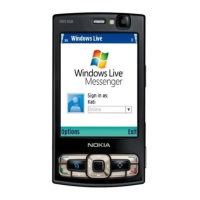Data, settings, and web service
messages
Your device can receive many kinds of messages that
contain data, such as business cards, ringing tones,
operator logos, calendar entries, and e-mail
notifications. You may also receive settings from your
service provider or company information management
department in a configuration message.
To save the data from the message, select Options and
the corresponding option.
Web service messages are notifications (for example,
news headlines) and may contain a text message or a
link. For availability and subscription, contact your
service provider.
Mailbox
Define the e-mail settings
Tip: Use Settings wizard to define your mailbox
settings. Press
, and select Tools >
Utilities > Sett. wizard.
To use e-mail, you must have a valid internet access
point (IAP) in the device and define your e-mail settings
correctly.
See "Access points", p. 142. See "E-mail
settings", p. 106.
You must have a separate e-mail account. Follow the
instructions given by your remote mailbox and
internet service provider (ISP).
If you select Mailbox in the Messaging main view and
have not set up your e-mail account, you are prompted
to do so. To start creating the e-mail settings with the
mailbox guide, select Start.
When you create a new mailbox, the name you give to
the mailbox replaces Mailbox in the Messaging main
view. You can have up to six mailboxes.
Open the mailbox
Press , and select Messaging and a mailbox.
When you open the mailbox, the device asks if you
want to connect to the mailbox (Connect to
mailbox?).
To connect to your mailbox and retrieve new e-mail
headings or messages, select Yes. When you view
messages online, you are continuously connected to a
remote mailbox using a data connection.
To view previously retrieved e-mail messages offline,
select No.
To create a new e-mail message, select New
message > E-mail in the Messaging main view or
Options > Create message > E-mail in your
mailbox.
See "Write and send messages", p. 100.
103
Messaging

